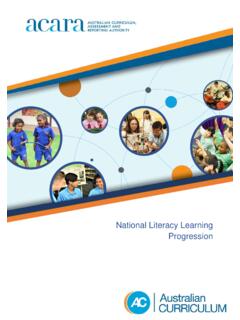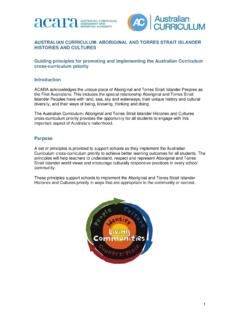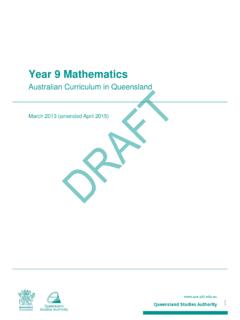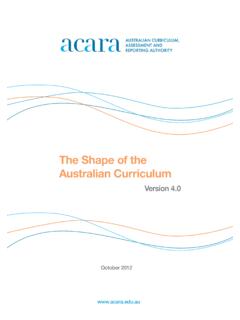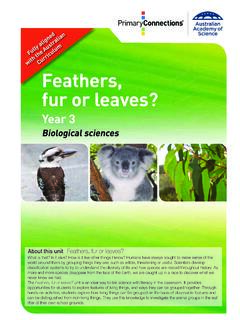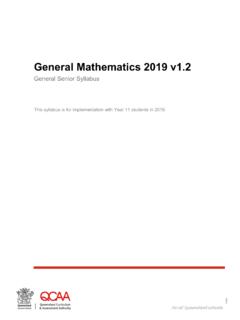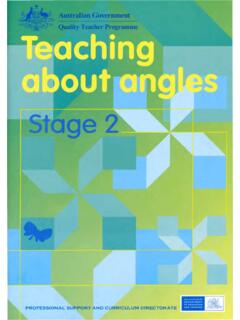Transcription of Mathematics - Sequence of Content - Australian Curriculum
1 ThreadFoundation YearYear 1 Year 2 Year 3 Year 4 Year 5 Year 6 Number and place valueEstablish understanding of the language and processes of counting by naming numbers in sequences, initially to and from 20, moving from any starting point (ACMNA001)Develop confidence with number sequences to and from 100 by ones from any starting point. Skip count by twos, fives and tens starting from zero (ACMNA012)Investigate number sequences, initially those increasing and decreasing by twos, threes, fives and tens from any starting point, then moving to other sequences (ACMNA026)Investigate the conditions required for a number to be odd or even and identify odd and even numbers (ACMNA051)Investigate and use the properties of odd and even numbers (ACMNA071)Identify and describe factors and multiples of whole numbers and use them to solve problems (ACMNA098)Identify and describe properties of prime, composite, square and triangular numbers (ACMNA122)Connect number names, numerals and quantities, including zero, initially up to 10 and then beyond (ACMNA002)Recognise, model, read, write and order numbers to at least 100.
2 Locate thesenumbers on a numberline (ACMNA013)Recognise, model, represent and order numbers to at least 1000 (ACMNA027)Recognise, model, represent and order numbers to at least 10 000 (ACMNA052)Recognise, represent and order numbers to at least tens of thousands (ACMNA072)Use estimation and rounding to check the reasonableness of answers to calculations (ACMNA099)Subitise small collections of objects (ACMNA003)Count collections to 100 by partitioning numbers using place value (ACMNA014)Group, partition and rearrange collections up to 1000 in hundreds, tens and ones to facilitate more efficient counting (ACMNA028)Apply place value to partition, rearrange and regroup numbers to at least 10 000 to assist calculations and solve problems (ACMNA053) Apply place value to partition, rearrange and regroup numbers to at least tens of thousands to assist calculations and solve problems (ACMNA073)Compare, order and make correspondences between collections, initially to 20, and explain reasoning (ACMNA289)Represent practical situations to model addition and sharing (ACMNA004)Represent and solve simple addition and subtraction problems using a range of strategies including counting on, partitioning and rearranging parts (ACMNA015)Explore the connection between addition and subtraction (ACMNA029)Solve simple addition and subtraction problems using a range of efficient mental and written strategies (ACMNA030)Recognise and explain the connection between addition and subtraction (ACMNA054)
3 Recall addition facts for single-digit numbers and related subtraction facts to develop increasingly efficient mental strategies for computation (ACMNA055)Investigate number sequences involving multiples of 3, 4, 6, 7, 8, and 9 (ACMNA074)Investigate everyday situations that use integers. Locate and represent these numbers on a number line (ACMNA124) Mathematics : Sequence of Content F-6 Strand: Number and Australian Curriculum December 2015 Page 1 ThreadFoundation YearYear 1 Year 2 Year 3 Year 4 Year 5 Year 6 Number and place valueRecognise and represent multiplication as repeated addition, groups and arrays (ACMNA031)Recall multiplication facts of two, three, five and ten and related division facts (ACMNA056) Recall multiplication facts up to 10 10 and related division facts (ACMNA075)Recognise and represent division as grouping into equal sets and solve simple problems using these representations (ACMNA032)Solve problems involving division by a one digit number, including those that result in a remainder (ACMNA101)Represent and solve problems involving multiplication using efficient mental and written strategies and appropriate digital technologies (ACMNA057)
4 Develop efficient mental and written strategies, and use appropriate digital technologies for multiplication and for division where there is no remainder (ACMNA076)Use efficient mental and written strategies and apply appropriate digital technologies to solve problems (ACMNA291)Solve problems involving multiplication of large numbers by one- or two-digit numbers using efficient mental, written strategies and appropriate digital technologies (ACMNA100)Select and apply efficient mental and written strategies and appropriate digital technologies to solve problems involving all four operations with whole numbers (ACMNA123)Investigate number sequences involving multiples of 3, 4, 6, 7, 8, and 9 (ACMNA074) Mathematics : Sequence of Content F-6 Strand: Number and Australian Curriculum December 2015 Page 2 ThreadFoundation YearYear 1 Year 2 Year 3 Year 4 Year 5 Year 6 Fractions and decimalsRecognise and describe one-half as one of two equal parts of a whole.
5 (ACMNA016)Recognise and interpret common uses of halves, quarters and eighths of shapes and collections (ACMNA033)Model and represent unit fractions including 1/2, 1/4, 1/3, 1/5 and their multiples to a complete whole (ACMNA058)Investigate equivalent fractions used in contexts (ACMNA077)Compare and order common unit fractions and locate and represent them on a number line (ACMNA102)Compare fractions with related denominators and locate and represent them on a number line (ACMNA125)Count by quarters halves and thirds, including with mixed numerals. Locate and represent these fractions on a number line (ACMNA078)Investigate strategies to solve problems involving addition and subtraction of fractions with the same denominator (ACMNA103)Solve problems involving addition and subtraction of fractions with the same or related denominators (ACMNA126)Recognise that the place value system can be extended to tenths and hundredths.
6 Make connections between fractions and decimal notation (ACMNA079)Recognise that the place value system can be extended beyond hundredths (ACMNA104)Find a simple fraction of a quantity where the result is a whole number, with and without digital technologies (ACMNA127)Compare, order and represent decimals (ACMNA105)Add and subtract decimals, with and without digital technologies, and use estimation and rounding to check the reasonableness of answers (ACMNA128)Multiply decimals by whole numbers and perform divisions by non-zero whole numbers where the results are terminating decimals, with and without digital technologies (ACMNA129) Mathematics : Sequence of Content F-6 Strand: Number and Australian Curriculum December 2015 Page 3 ThreadFoundation YearYear 1 Year 2 Year 3 Year 4 Year 5 Year 6 Fractions and decimalsMultiply and divide decimals by powers of 10 (ACMNA130)Make connections between equivalent fractions, decimals and percentages (ACMNA131)Real numbersThis Sequence starts at Year 7 Money and financial mathematicsRecognise, describe and order Australian coins according to their value (ACMNA017)Count and order small collections of Australian coins and notes according to their value (ACMNA034)Represent money values in multiple ways and count the change required for simple transactions to the nearest five cents (ACMNA059)Solve problems involving purchases and the calculation of change to the nearest five cents with and without digital technologies (ACMNA080)Create simple financial plans (ACMNA106)
7 Investigate and calculate percentage discounts of 10%, 25% and 50% on sale items, with and without digital technologies (ACMNA132)Patterns and algebraSort and classify familiar objects and explain the basis for these classifications. Copy, continue and create patterns with objects and drawings (ACMNA005)Investigate and describe number patterns formed by skip-counting and patterns with objects (ACMNA018)Describe patterns with numbers and identify missing elements (ACMNA035)Describe, continue, and create number patterns resulting from performing addition or subtraction (ACMNA060)Explore and describe number patterns resulting from performing multiplication (ACMNA081)Describe, continue and create patterns with fractions, decimals and whole numbers resulting from addition and subtraction (ACMNA107)Continue and create sequences involving whole numbers, fractions and decimals.
8 Describe the rule used to create the Sequence (ACMNA133)Solve problems by using number sentences for addition or subtraction (ACMNA036)Solve word problems by using number sentences involving multiplication or division where there is no remainder (ACMNA082)Explore the use of brackets and order of operations to write number sentences (ACMNA134) Mathematics : Sequence of Content F-6 Strand: Number and Australian Curriculum December 2015 Page 4 ThreadFoundation YearYear 1 Year 2 Year 3 Year 4 Year 5 Year 6 Find unknown quantities in number sentences involving addition and subtraction Identify equivalent number sentences involving addition and subtraction (ACMNA083)Find unknown quantities in number sentences involving multiplication and division. Identify equivalent number sentences involving multiplication and division(ACMNA121)Linear and non-linear relationshipsThis Sequence starts at Year 7 Mathematics : Sequence of Content F-6 Strand.
9 Measurement and geometryUsing units of measurementUse direct and indirect comparisons to decide which is longer, heavier or holds more, and explain reasoning in everyday language (ACMMG006)Measure and compare the lengths and capacities of pairs of objects using uniform informal units (ACMMG019)Compare and order several shapes and objects based on length, area, volume and capacity using appropriate uniform informal units (ACMMG037)Measure, order and compare objects using familiar metric units of length, mass and capacity (ACMMG061)Use scaled instruments to measure and compare lengths, masses, capacities and temperatures (ACMMG084)Choose appropriate units of measurement for length, area, volume, capacity and mass (ACMMG108)Connect decimal representations to the metric system (ACMMG135)Compare and order duration of events using everyday language of time (ACMMG007)Connect days of the week to familiar events and actions (ACMMG008)Tell time to the half-hour (ACMMG020)Describe duration using months, weeks, days and hours (ACMMG021)Tell time to the quarter-hour, using the language of past and to (ACMMG039)Name and order months and seasons (ACMMG040)Use a calendar to identify the date and determine the number of days in each month (ACMMG041)Tell time to the minute and investigate the relationship between units of time (ACMMG062)Use am and pm notation and solve simple time problems (ACMMG086)Convert between units of time (ACMMG085)Compare 12- and 24-hour time systems and convert between them (ACMMG110)Interpret and use timetables (ACMMG139) Mathematics : Sequence of Content F-6 Strand.
10 Number and Australian Curriculum December 2015 Page 5 ThreadFoundation YearYear 1 Year 2 Year 3 Year 4 Year 5 Year 6 Compare masses of objects using balance scales (ACMMG038)Compare objects using familiar units of area and volume (ACMMG290)Calculate perimeter and area of rectangles using familiar metric units (ACMMG109)Convert between common metric units of length, mass and capacity (ACMMG136)Solve problems involving the comparison of lengths and areas using appropriate units (ACMMG137)Connect volume and capacity and their units of measurement (ACMMG138)ShapeSort, describe and name familiar two-dimensional shapes and three-dimensional objects in the environment (ACMMG009)Recognise and classify familiar two-dimensional shapes and three-dimensional objects using obvious features (ACMMG022)Describe and draw two-dimensional shapes, with and without digital technologies (ACMMG042)Make models of three-dimensional objects and describe key features (ACMMG063)Compare the areas of regular and irregular shapes by informal means (ACMMG087)Connect three-dimensional objects with their nets and other two-dimensional representations (ACMMG111)Construct simple prisms and pyramids (ACMMG140)Describe the features of three-dimensional objects (ACMMG043)Compare and describe two dimensional shapes that result from combining and splitting common shapes, with and without the use of digital technologies (ACMMG088)Location and transformationDescribe position and movement (ACMMG010)Give and follow directions to familiar locations (ACMMG023)

